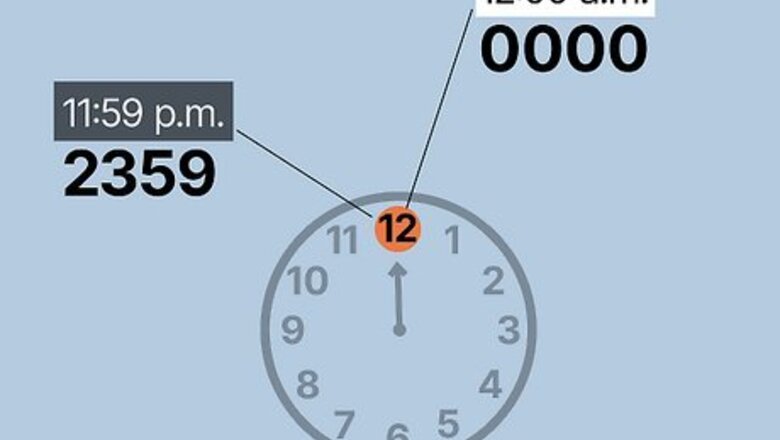
views
- Write midnight (12:00 a.m.) as 0000. For all other single-digit a.m. hours, add a zero before the hour (for example, 9:45 a.m. is 0945).
- For 10 a.m. through 12:59 p.m., just take away the colon. For example, 11:32 a.m. is 1132.
- For 1 p.m. and later, add 12 to the hour. For example, 4:52 p.m. is 1652, and 11:07 p.m. is 2307.
Converting 12-Hour Time to Military Time

Write midnight (12:00 a.m.) as 0000 (“zero hundred hours”). Instead of having a 12-hour clock that resets twice, the military clock starts at midnight (0000 hours) and runs for 24 hours through 11:59 p.m. (2359 hours) before resetting at 0000 hours. In these 4-digit times, the first two numbers represent the hour of the day, and the second two numbers represent the minutes within that hour. Note that the military clock does not use a colon to separate the hours and minutes. There is no need to specify a.m. or p.m. in military time since the clock runs for 24 hours. Contrary to popular belief, the military does not call midnight 2400 hours, or “twenty-four hundred hours” (although some other organizations may use this terminology).

Add a zero before the hour for times from 1:00 a.m. through 9:59 a.m. For example, 1:00 a.m. becomes 0100 hours (“zero one hundred hours”), 2:00 a.m is 0200 hours (“zero two hundred hours”), and so on. Remember to leave out the colon and add two zeros after the hour (like in standard 12-hour time). 1 a.m. is 0100 hours. 2 a.m. is 0200 hours. 3 a.m. is 0300 hours. 4 a.m. is 0400 hours. 5 a.m. is 0500 hours. 6 a.m. is 0600 hours. 7 a.m. is 0700 hours. 8 a.m. is 0800 hours. 9 a.m. is 0900 hours.

Write 10:00 a.m. through 12:00 p.m. without a colon. When you reach the 2-digit hour times after 9:59 a.m., just remove the colon to convert them to military time. For example, 10:00 a.m. becomes 1000 hours (“ten hundred hours”), 11:00 a.m. becomes 1100 hours (“eleven hundred hours”), and 12:00 p.m. becomes 1200 hours (“twelve hundred hours”).
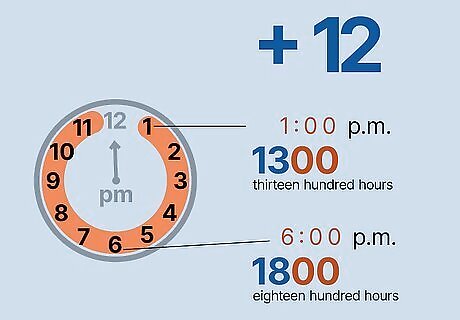
Add 12 to hours from 1:00 p.m. through 11:59 p.m. In military time, you don't start a new 12-hour cycle after noon, but continue to count beyond 1200 instead. So, 1 p.m. becomes 1300 hours (“thirteen hundred hours”), 2 p.m. becomes 1400 hours (“fourteen hundred hours”), and so on. This continues until midnight, when the clock resets to 0000 hours. 1 p.m. is 1300 hours. 2 p.m. is 1400 hours. 3 p.m. is 1500 hours. 4 p.m. is 1600 hours. 5 p.m. is 1700 hours. 6 p.m. is 1800 hours. 7 p.m. is 1900 hours. 8 p.m. is 2000 hours. 9 p.m. is 2100 hours. 10 p.m. is 2200 hours. 11 p.m. is 2300 hours.

Pronounce hours without minutes as “[number] hundred hours.” If you're dealing with whole hours without any minutes and there's a zero as the first digit, then say the first two digits as “zero” and whatever number is next, followed by “hundred hours.” For example, if there's a 4 as the first digit, then say “zero four hundred hours.” For 2-digit hours from 1000 to 2300, simply say the hour number followed by “hundred hours” For example, 1300 would be “thirteen hundred hours.” Here are some more examples: 0100 hours is “zero one hundred hours.” 0200 hours is “zero two hundred hours.” 0300 hours is “zero three hundred hours” and so on until 0900 hours. 1100 hours is “eleven hundred hours.” 2300 hours is “twenty-three hundred hours.” Note that in the military, “zero” is always used to signify the zero digit in front of a number. “Oh” is used more casually. Note that using “hours” is optional. For example, you could say 0300 as “zero three hundred.”

Say hours with minutes as “[hour number] [minute number] hours.” When you tell military time, state the 4-digit number as two pairs of numbers—the first pair of two numbers represents the hour, and the second pair represents the minutes. For example, 1545 becomes “fifteen forty-five hours” or just “fifteen forty-five.” Here are some more rules for this process: If there are one or more zeros in front of the number, say them. 0003 (12:03 a.m.) is “zero zero zero three hours” and 0215 (2:15 a.m.) is “zero two fifteen hours.” If there are no zeros in the first two digits of the number, say the first two numbers as a set and do the same with the last two digits. For example, 1234 becomes “twelve thirty-four hours,” 1404 becomes “fourteen zero four hours,” and 0130 is “zero one thirty.”
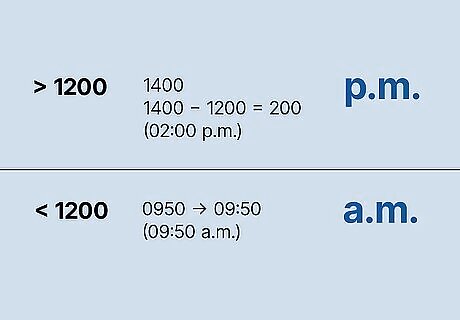
Practice converting military time to regular time. If you see a number greater than 1200, that means you've reached the afternoon hours, so just subtract 1200 from that number to get the time using the 12-hour clock. For example, 1400 hours is 2 p.m. in standard time because you get 200 when you subtract 1200 from 1400. 2000 hours is 8 p.m. because when you subtract 1200 from 2000, you get 800. If you're looking at a time less than 1200, then you know you're working with numbers from midnight until noon. Simply use the first two digits to get the a.m. hour, and the last two digits to get the minutes to convert to military time. For example, 0950 hours means 9 hours and 50 minutes, or 9:50 a.m. 1130 hours means 11 hours and 30 minutes, or 11:30 a.m.
Military Time Conversion Chart
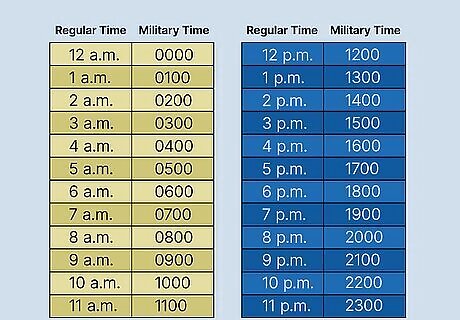
Use a conversion chart for reference until you memorize the times. To help you memorize faster, remember that times from midnight until 12:59 a.m. begin with 00. To make converting times from 1:00 p.m. to 11:59 p.m. easier, just add 12 to the normal hour number. For example, 2:44 p.m. would be 1444 (“fourteen forty-four”) because 2 + 12 = 14.
Who uses military time and why?
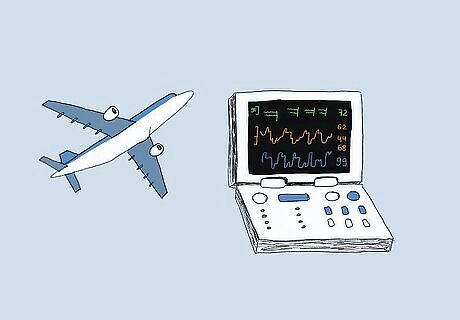
Military, medical, and scientific personnel use military time for precision. Have you ever set your alarm clock for 8 p.m. instead of 8 a.m. on accident? In certain settings, like hospitals, the army, or airlines, this type of confusion can have highly inconvenient or even deadly consequences. To have zero risk of mixing up a.m. and p.m. hours, these industries use military or 24-hour time. Some whole countries even use military or 24-hour time as their standard way of keeping time, including the UK, Germany, Australia, India, the Philippines and more. The US
History of Military Time

The ancient Egyptians devised the first 24-hour time keeping system. They based their hours off of the movement of 24 stars (12 for daytime hours and 12 for nighttime hours). However, these hours were of different lengths due to the changing of the seasons. The ancient Greeks conceptualized 24 even hours in a day, and using 24-hour sundials (and eventually clocks) came to be standard in many parts of the world by the Middle Ages. During the Industrial Revolution and the spread of railways, standardized 24-hour time became essential to make sure rail passengers in different time zones and locations could reliably catch their trains. Today, many countries use 24-hour time as their standard method of timekeeping. In the US, it is primarily used only in the military and other scientific industries, which is why it’s known here as “military time.”
















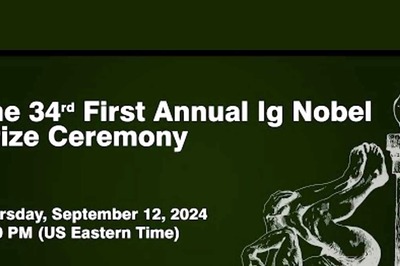
Comments
0 comment